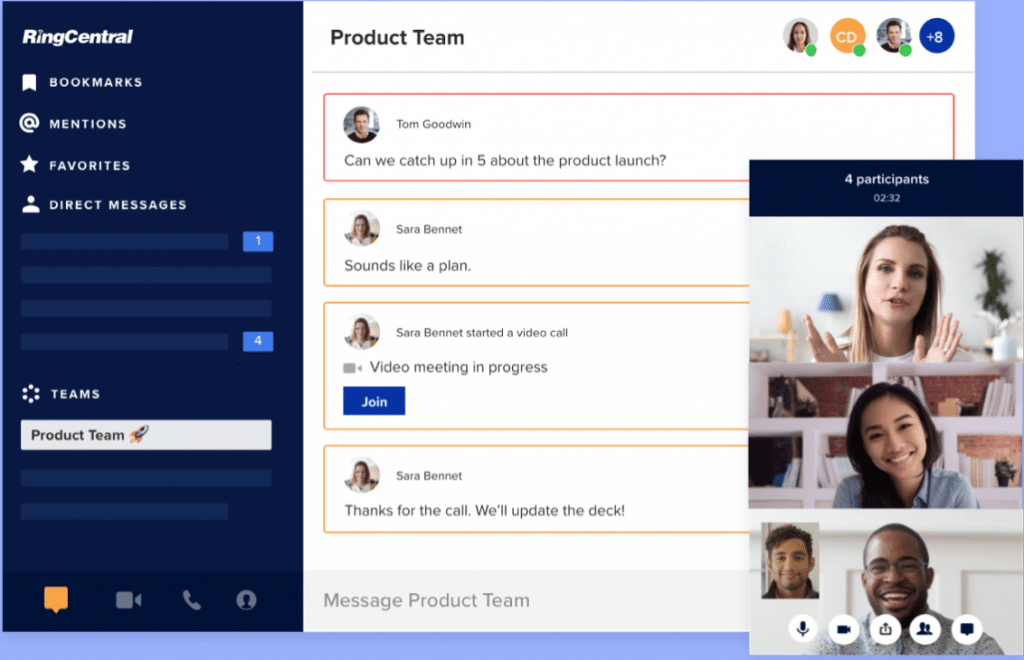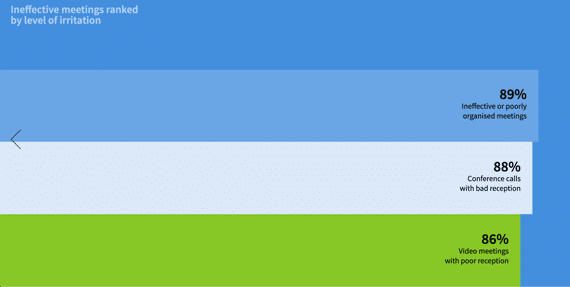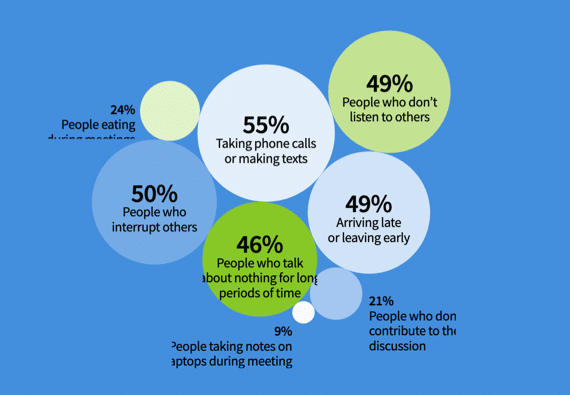The sales meeting spectrum has two ends. On one end is the stuff that crops up on YouTube when you search for a Grant Cardone event: everyone standing around breaking into fervent applause and cheering every other minute—a wealthy introvert hell.
At the other end, you have the dead-end sales meeting where all the attendees are cringing and groaning, “Oh, here we go again.”
As much as people hate meetings, meetings are useful—and having them regularly is important. Under an avalanche of quarterly targets and financial pressure, employers often get desperate to motivate their salespeople to perform and try to throw money at a problem that plagues almost every company in operation today (except maybe Grant Cardone’s).
Every year, US companies spend about $800 billion on sales team compensation alone—and blame a bad compensation program when things aren’t going well. It’s about three times more than their advertising spending.
But here’s the thing: it doesn’t work like that. Research shows that almost always, employees don’t perform because of external motivators or pressure tactics. They perform because they want to, because they intrinsically feel the desire to excel.
So what does work?
In this article, we’ll cover:
- The importance of good sales meetings
- How to motivate your sales team under pressure
- 9 sales meeting ideas to recharge your team spirit
- How to run a super-short motivational sales meeting in 7 steps
🌟 Make sure every sales meeting is productive with our set of 5 free meeting agenda templates—each one tailored for a different type of meeting.
The importance of good sales meetings
If you want to check the pulse of your company’s culture, drop in on a sales meeting. It won’t tell you if you’re going to exceed that month’s targets, but it will tell you a few other things:
- How engaged your employees are
- How well your sales team’s day is going to go
- Whether they care about your company’s success
Bad sales meetings look like a roomful of lethargy—perhaps there’s a manager droning on about the sales software and slouching reps breaking into disappointed murmurs in the middle of a presentation, maybe even complaining about their company.
In good sales meetings on the other hand, there’s a liveliness in the atmosphere, with reps participating enthusiastically. There’s genuine camaraderie, maybe even a whiff of a healthy competitive spirit. More importantly, reps leave feeling respected, recharged, and ready to seize the day.
The bottom line? Having a good sales territory plan is important, but amazing sales meetings might just be equally effective (and an inexpensive way) to motivate your reps. But they require a bit of a paradigm shift.

How to motivate your sales team under pressure
Before launching into an effusive motivational speech, consider why your employees might not be motivated in the first place. Academics Richard E. Clark and Bror Saxberg’s review of motivation research identified that people lose motivation to perform because:
- They don’t care enough to do it.
- They don’t believe they’re able to do it,
- They’re too consumed by negative emotions such as anxiety or anger.
- They don’t really understand why they’re struggling with it.
Once you identify the reasons your employees aren’t performing, tailor your communication accordingly.
Shield them from the pressures of quarterly targets and do your best to create an environment that makes them want to care and believe in themselves. Do this by:
- Focusing on the process (number of calls made), not the results (number of deals closed)
- Building their capabilities through training and master classes
- Creating a sense of belonging in the team
For best results, build these insights into your sales meetings consistently, and not just when their morale is low.
Learn how to have more productive meetings with the Guide to Better Meetings.
9 motivational sales meeting ideas to get your employees to perform
While running your sales meetings, forget terms like “motivation” and “engagement,” and think “belonging,” “trust,” and “purpose.” Use the following ideas to incorporate these elements into your meeting.
1. Watch a video together
Some sales teams do book clubs, where they read sales-related books and share their learnings during meetings. Reading isn’t always everyone’s jam, but videos are. Watch a motivational video or a great sales demo video (or watch a classic sales movie), then discuss it together.
Meeting with a remote team? Use the screen share function in your video conferencing software to watch a video together.
2. Create a virtual water cooler

You can even jump into a video meeting straight from your team’s chat if you’re using an app like RingCentral.
In a live, everyday setting, employees go out of a meeting room to gather for an informal conversation at the office water cooler or a coffee machine.
It’s a great idea to create a group on your team messaging platform or communication tool that’s a dedicated informal space where your team can have non-work-related discussions.
3. Play games
Nothing brings people together and builds effective teamwork like play. If team basketball sessions aren’t your thing, introduce gamification into seemingly mundane aspects.
Have a fun pop-quiz on your company’s newest product features, or have your employees stage skits to see who can come up with the best sales conversation starters. Bring out the board games—or not. Most games can be played without any equipment.
Here are a few virtual team building activities to try.
4. Share experiences
“Nothing affirms an employee’s great work more than a leader saying, ‘That was amazing! Tell me how you did it?’” bestselling author Ron Carucci writes. That’s one way of showing your collaborative leadership qualities.
“By asking for, and listening intently to, the story behind an accomplishment, you acknowledge that the contribution is an extension of its contributor and helps them feel that they, and their work, really matter.”
Encourage your best performers for the week to share how they closed their biggest deals and good sales pitch examples they’ve tried. It gives their teammates something to learn from.
5. Invite an expert
Your team is bound to get bored of hearing the same people speak over and over again. Want to teach them something? Why not invite an expert to address them? If the expert is someone your team admires, it’ll be exciting.
Again, if you’re using a video conferencing software, like RingCentral Video, you can invite a speaker from anywhere in the country to do a webinar or even a live “Ask Me Anything” with your team.
6. Try a new venue
It’s always nice to mix things up. It gives people something to look forward to. Try having a stand-up meeting at a park, or discuss the quarterly performance at the new restaurant in town. Having meals together is a great way to bond.
And if you’re running these meetings virtually, why not switch on your webcams and enjoy the meal together?
7. Have a masterclass
Increase your reps’ confidence through classes focused on improving their selling technique. It could be something easy like how to create an effective client sales meeting agenda, or a multi-class session on a bigger topic like running demos. As you spend more time getting to know your reps, you’ll also understand their day-to-day difficulties. Have monthly master classes on topics that your reps would like you to cover.
8. Run contests
Foster a healthy sense of competition in your team—by rewarding effort. Who’s made the most calls? Who’s sent out the largest number of cold pitches? Reward your winners with coupons to their favourite restaurants or give them useful rewards like a new top-of-the-line Bluetooth headset.
Have a leaderboard in your office or on your project management tool and update it weekly.
Salesforce is a great CRM and all-around sales app that comes with a leaderboard. If yours doesn’t, tools like Klipfolio and CRM Gamified make virtual leaderboards that integrate with your existing apps.
9. Celebrate everything
Celebrate winners of your in-house contests. Celebrate the deals closed and the target-busters. Celebrate birthdays and anniversaries. This is a great way to create a sense of belonging at work.
How to run a brief motivational sales meeting in 7 steps
Effective planning can keep your sales meetings short but full of substance, and short sales meetings hold your reps’ attention better. The steps given below apply even for remote teams:
Step 1: Create your agenda
A good agenda will mark out a minute-to-minute schedule of what to cover. Attach any PPTs you’d like to present (though we’d advise not using any) to the agenda, so you won’t have to waste time going over them later.

People hate poorly organized meetings. So make sure yours is on point.
Source: Doodle’s State of Meetings Report 2019.
Step 2: Share it 24 hours in advance
Circulating the agenda in advance gives your reps ample time to come to the meeting prepared with their thoughts and questions. You can also create a group in your team messaging platform dedicated to discussions around meetings on the same app you use to make your video calls:
Use a standardized sales meeting template to save time.
Step 3: Prepare
Gather all the materials you need in advance. Are you running a quiz? Make sure you’ve got the materials together. If you’re running an online meeting, put away the loose wires hanging from your shelf in the background, and test your mic and camera settings to minimize technical glitches.
According to Doodle’s “2019 State of Meetings” report, 49% of respondents hate it when people arrive late and leave early from meetings. So, be on time and make sure everyone else is, too.
Step 4: Arrive earlier than everyone else
As your reps trickle into the meeting room (real or virtual), make sure you’re there to greet them. Ask them about their day or week (and if you’re really feeling it, stir up some light and lively banter).
Step 5: Follow the agenda
If you’re typically a rambling sort of speaker, Learn to stick to the agenda. The effort will be worth it.
Try Gary Vaynerchuk’s technique of mandatorily slashing all meeting times by half. It’s a great way to challenge yourself to keep non-essential discussions to a minimum.
Step 6: Open the floor
Employees who feel heard are employees who feel engaged. It’s essential that you bookend your meetings with five minutes of dedicated active listening and reflection. Leaders often ask, “Any questions?” but hardly give people enough time to gather their thoughts and reply. Don’t do that.
Step 7: Reflect
Send out the minutes of the meeting after every meeting, so those who weren’t present can catch up on what they missed (and hopefully, regret it).
If you’re running virtual meetings, RingCentral Video allows you to record meetings and even make annotations as you’re screen sharing, so you can watch them later to observe the areas that need improvement:

Learn more about screen sharing software options your sales team can try.
Motivational sales meetings don’t have to be so hard
If you’re new to handling a sales team, know that you’re not alone. Employee engagement and motivation are actually tough, and most companies don’t have them figured out.
Take it one step at a time. With humility, planning, and a few creative ideas to keep things fresh, you’ll do just fine.
Originally published Mar 02, 2020, updated Jun 19, 2024








